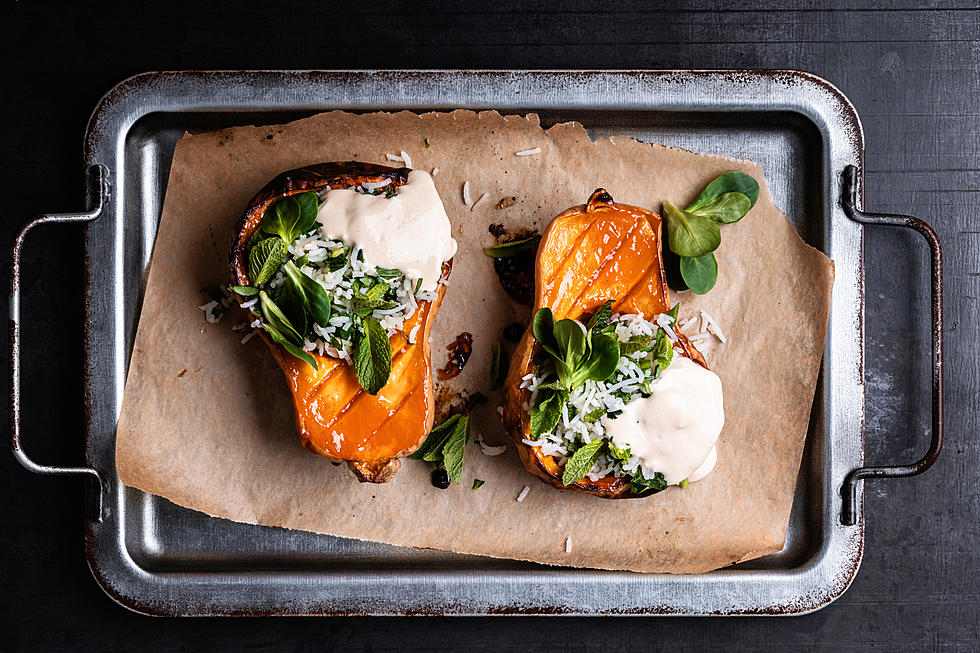
11 Fall Foods to Fight Infection, Boost Energy, Prevent Weight Gain, from RDs
Want to be healthier this season? Registered Dietitians share what they're buying this fall in order to fight infection, have more energy, and keep weight gain at bay. Here, we peak into the grocery shopping carts of RDs who share their favorite plant-based foods to eat now and all winter, to be your healthiest this season.
“Plant foods are a great way to stay healthy and glowing this fall and holiday season,” says registered dietitian Lauren O’Connor, MS, RDN, author of Healthy Cooking for One Cookbook. “Truth be told, we should always be loading up on nature’s perfect eats."
She adds that incorporating a wide variety of plant foods into your lifestyle will not only bring color and complexity of taste to your holidays but also add "a diversity of immune-boosting, health-promoting nutrients.”
11 fall foods to fight infection, avoid weight gain and have more energy
1. Hardy Greens
“Hardy greens like collards and kale start popping up at the farmers market this time of year,” says Marisa Moore, MBA, RDN, LD, culinary and integrative dietitian at MarisaMoore.com. “They taste better in the cooler weather but are brimming with vitamin A, vitamin K, folate, and vitamin C. Collards are particularly high in vitamin K, which is known for its essential role in blood clotting and maintaining bone health.”
In fact, according to a 2021 study, one cup of leafy greens a day helps build muscle strength; you don’t have to tell us twice to toss up that kale salad.
2. Walnuts
Love walnuts? Us too, and there’s good reason to eat them regularly, especially if you follow a plant-based diet. “One of my favorite fall foods is walnuts because they’re such a great addition to so many seasonal recipes, such as plant-based chili, pumpkin-spiced overnight oats, and seasonal roasted veggies.
Walnuts are the only nut with an excellent source of omega-3 alpha-linolenic acid (ALA), a nutrient that can be lacking in a vegan diet. The omega-3 family includes ALAs as well as EPA and DHA, which are found in fatty fish. If you’re not eating fish, it’s even more important to eat foods like walnuts because ALA converts to the omega-3 fatty acids found in fish,” says Samantha Cassetty, MS, RD, nutrition and wellness expert and co-author of Sugar Shock.
“In a small study among people with low omega-3 intake, eating two servings of walnuts per day led to a significant increase in total omega-3 fatty acids in participants’ plasma. Meanwhile, other research suggests that ALA may be as effective in reducing the risk of heart disease as the omega-3s derived from marine sources. So, it’s really crucial for vegans to add ALA-rich foods, like walnuts, to meals and snacks.”
3. Sharon Fruit
“I love Sharon fruit, a type of persimmon (often labeled a ‘fuyu’ persimmon), but not the acorn-shaped ones that have to get really soft to be eaten without puckering your mouth,” shares Keith-Thomas Ayoob, EdD, RD, FAND, Associate Clinical Professor Emeritus, Department of Pediatrics, at the Albert Einstein College of Medicine, and founder of Cut to the Chase Nutrition. Ayoob describes ‘em as sweet with a hint of cinnamon and nutmeg.
“This study found that fruit intake decreases during fall and winter, and that's probably due in part to the more limited variety of fresh fruit,” he continues, adding that Sharon fruit is loaded with potassium, vitamin C, fiber, and antioxidants like beta-carotene. In addition to eating them raw, try slicing them and tossing them into salads or your favorite plant-based yogurt.
4. Brussels Sprouts
“Brussels Sprouts add a great texture to [meals],” comments O’Connor. “ Grilled up in garlic or baked to perfection with a drizzle of oil and a touch of sea salt, these cruciferous bites add nutritional density to your meals,” she says, adding that the glucosinate compounds in Brussels Sprouts have been linked to decreased cancer risk.
These days, we’re loving this sweet and spicy Brussels sprouts recipe.
5. Butternut Squash
Roasted Butternut Seasoned in Garam Masala With Homemade Naan, here we come.
“Butternut squash provides a sweet and satisfying addition to your fall meals. High levels of carotenoids impart benefits for heart health, immunity, and anti-inflammatory properties, says O’Connor, pointing to this study. “And did you know, Carotenoids may be helpful in the absorption of iron? That’s good news for those who suffer from anemia.” For more on how to get enough iron on a plant-based diet, check out our guide here.
Riffing on O’Connor, Moore adds that winter squashes such as Butternut squash are loaded with vitamin A “and research suggests that yellow and orange vegetables might help reduce the risk of heart disease.” As far as cooking it? “I usually keep the prep simple by roasting the squash or adding it to soup or stew,” Moore says.
6. Mushrooms
“Though you can find mushrooms year-round, their peak growing season is fall through winter. Meanwhile, they’re an ideal fall food since they can be a valuable source of vitamin D, especially if you’re exclusively plant-based. Vitamin D is considered the sunshine vitamin because when your skin is exposed to the sun, it activates vitamin D production in your body. However, during the fall, the days get shorter, so you get less sunlight. That makes it even more important to get vitamin D through foods,” explains Cassetty. “And for vegans, mushrooms are the best source of this nutrient outside of fortified foods. That’s because, like your skin, mushrooms synthesize vitamin D when exposed to sunlight or sunlamps.”
“Plus, mushrooms have antiviral and antibacterial properties along with immune-supporting nutrients, including selenium, so they’re a perfect addition to your fall menu when cold and flu activity ramps up,” she further notes. Which reminds us, add some of these plant-based foods to your fall food shopping list, too, in order to boost your immune system and fight sickness.
7. Oranges
“Oranges are a fall/winter fruit, and they can really pick up the slack in fruit consumption that fades during colder weather,” says Ayoob. “Whole oranges are great, but this is one time I'm a fan of the juice, and the commercially prepared juice: hesperidin is a powerful antioxidant that helps prevent cell damage. It's found mostly in the pith and peel of citrus fruits. Commercial squeezing is far more powerful and gets more of the hesperidin out of the pith and peel and into the juice.” Ayoob recommends consuming four-to-eight ounces of OJ daily.
FYI: Make sure you’re drinking 100% orange juice and not an “orange drink” or a juice that is blended with other ingredients and potentially added sugars, Ayoob cautions.
8. Grapes
Moore says she’ll definitely be loading up on grapes this fall. “Grapes may support a healthy heart by promoting relaxation of blood vessels for healthy blood flow and function. Heart-healthy grapes of all colors are great on their own — just rinse and add them to your fall or holiday table,” she says. “Snack on them fresh or add grapes to all kinds of recipes from salads and salsas to sweet and savory appetizers to round out a snack board.”
Try this weight-loss-friendly combo of edamame and grapes for an easy and satiating snack.
9. Apples
Whether you’re picking them at an orchard, buying them at the farmers’ market, or grabbing them at the supermarket, this is a great addition to your diet, in the fall, and year-round. “Apples are rich in quercetin, a flavonoid with potent antioxidant and anti-inflammatory effects that is also thought to have potential protective effects against heart disease. Much of the quercetin and other phytonutrients in apples are concentrated in the peel, so leave it on if possible,” advises Charlotte Martin, MS, RD, author of The Plant-Forward Solution: Reboot Your Diet, Lose Weight & Build Lifelong Health by Eating More Plants & Less Meat.
“Apples also contain pectin, a type of soluble fiber that can support digestive health by promoting regularity and functioning as a prebiotic, feeding good gut bacteria, and encouraging their production of health-promoting metabolites known as short-chain fatty acids.”
10. Beans
‘Tis the season for soups and stews and chili galore. “They're the most underappreciated item in the food supply. Just half a cup of pinto beans four times per week has been shown to lower LDL-cholesterol 19 points, with the majority of that being the LDL (‘bad’) cholesterol,” offers Ayoob. “This research was done with canned pinto beans, so you don't have to start from scratch with dry beans to get these great results,” he elaborates, adding that it’s not only pinto beans that are good for you.
“Swap in your favorite beans, like chickpeas, which are another go-to of mine and are always in my pantry. Plus, I love the versatility of beans — I add them to salads, soups, stews, and you can add them at the last minute,” he adds, pointing to his family's very easy hummus recipe.
11. Cranberries
“These ruby red gems provide a tart-sweet addition to your holiday/festive dishes and are a great addition to a harvest bowl or autumn casserole. And a little goes a long way,” says O’Connor. “True, most cranberry dishes are sweetened and dried cranberries have added sugars to some extent, but according to current research, consumption of cranberries may extend beyond gut health to cardiovascular benefits including improved lipid profile and (particularly in juiced form) a reduction in blood pressure.”
Also, you may be surprised, but snacking on a handful of cranberries raw is actually a nice, picker-up snack. Or, add them to your favorite overnight oats recipe or stir them into oatmeal right before serving.
More From The Beet









